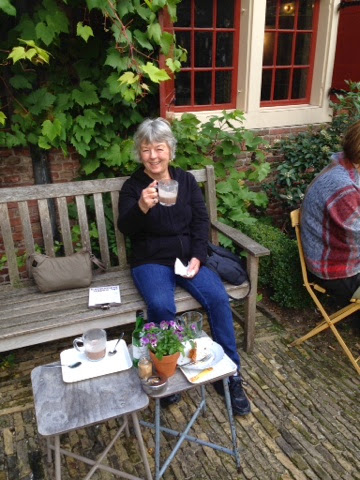Although originally built as a Catholic Church with 39 highly decorated altars when Amsterdam joined the revolt against Spain and switched from Papist to Puritan, in 1578, Oude Kerke became a Protestant Church. Inn 195 the church was closed because it was about to collapse. In 1955 reconsturction started on the church and has only recently been complerted.
Today the Oude Kerk frequently hosts exhibitions and concerts.
 The Mirror Room. The name of this room refers to the large mirror hanging above the fireplace. After the Alteration (1578) this room became the office of the Commissionairs of Marital Affairs. According to the new reformed religion, marriage was a state affair.
The Mirror Room. The name of this room refers to the large mirror hanging above the fireplace. After the Alteration (1578) this room became the office of the Commissionairs of Marital Affairs. According to the new reformed religion, marriage was a state affair. On 10 June 1634 Rembrandt signed his marriage registry, his bethrothed, Saskia van Uyllenburg was represented by a minister.
 The main organ which is being worked on. There are four organs in all in the church. This is the most visible.
The main organ which is being worked on. There are four organs in all in the church. This is the most visible. The Lady's chapel's stained-glass windows.
This chapel was built in 1555 and three stained glass windows were installed. The themes of the three windows are : The Annunciation, The Adoration of the Shepherds, and The Virgin Mary on her deathbed. The church was stormed by a mob in 1566 and fortunately they did have time to pillage all the art and the windows of the Lady Chapel survivied. These windows only required a few minor changes when Asterdam made its denominational Alteration around 12 years later; removing the radiant aureole around the head of each saint proved far less radical.
The Oude Kerk contains some 12,000 graves and around 2500 gravestones.
 This is the grave of Rembrandt's wife, Saskia Uylenburgh. Rembrandt is buried in a pauper's grave at the Nieuwe Kerk (New Chruch).
This is the grave of Rembrandt's wife, Saskia Uylenburgh. Rembrandt is buried in a pauper's grave at the Nieuwe Kerk (New Chruch).There are two types of graves: church graves and family graves. Church graves (marked with a K) were cheaper. Four burial layers were available in each grave. After a few years, the bones were disinterred and collected for reburial at a deeper level. In the eighteenth century, excavated bones were laid to rest elsewhere, in special ossuaries beneath the tower and under the outbuildings around the church. Those who could afford a family grave ( flithy stinking rich )could bury their dead in a specific place. Here too, bodies were buried in layers, and every few years the bones were disinterred and replaced lower down. One of the reasons incense was used in the church was to cover up the the ordors of decaying bodies.
Eventually the Dutch government prohibited this unhygienic pracitice of church burials. Yet Amsterdam's Reformed Church was reluctant to give up the lucrative source of income. In 1866 a ban on burials in the church was implemented by Oude Kerk.
Today all graves have been excavated and filled with white sand.
Hester Hooft ( 1748-1795) is buried here."Why my hand?" she asked Casanova when he wanted to kiss her hand. She gave him "a very modest kiss which went straight to the heart" writes Casanova in his diary. (Hester was 11 or 12 years old.
Jan Peter Sweelinck (1562-1621) put Oude Kerk on the map. On weekdays at 6:00 and on Sundays before and after the service music fans would come to hear him play. He was made full time organist in 1580. While some Puritans may have considered his keyboard playing frivolous, the burgesses, who now owned the church thought differently. He was the leading Dutch composer of the eary modern period, a bridge between the Renaissance and the Baroque. In fact Sweetlinck was a major influence on the young Johann Sebastian Bach. He played at the church for 44 years and it was here he was buried.
After completing our visit of the church proper we went and had a cup of coffee in their little cafe.
They had a number of areas where you could sit and enjoy either lunch or have something to drink and they also had free WIFI!



















No comments :
Post a Comment